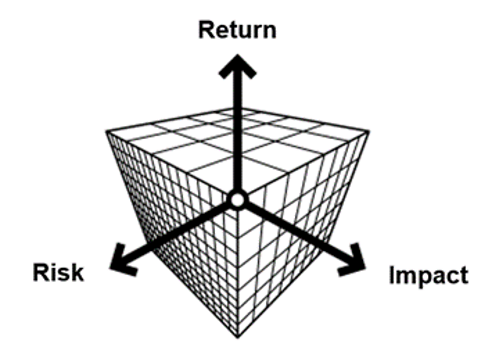3D Climate Optimiser
Lower your contribution to global warming while maximising risk-adjusted returns
Why a 3D Climate Optimiser?
Investors commonly rely on a portfolio optimisation approach developed in 1952 by Nobel Prize laureate, Harry Markowitz, to find the best trade-off between risk and return. Nowadays, investors increasingly want to know how their portfolio contributes to global warming. To this end, we created a portfolio optimiser that incorporates all three dimensions: risk, return and contribution to global warming (expressed as a simple “temperature” in degrees Celsius).
This temperature is an assessment of where a company sits on the transition path to net zero relative to a Paris-aligned benchmark, designed to limit global warming to 1.5-2°C. The aggregate portfolio temperature is then calculated as the weighted average temperature of the portfolio’s underlying companies. For example, a 3°C portfolio is a portfolio aligned with a world where global temperatures rise 3°C above pre-industrial levels by 2100. Currently, the world economy is on a 3°C trajectory.
The 3D Climate Optimiser finds the portfolio allocation delivering the best trade-off between expected return, risk and climate impact.
Input your portfolio holdings and define their parameters:
[Inputs can be individual securities, funds, ETFs or managed strategies. For illustrative purposes, we have pre-populated with sample global equity and bond managers. Click the toggle on the right to remove the position from the optimisation process. Click the pencil to update input parameters and click the plus sign to add your own portfolio holdings.]
| Name | Temperature | Expected Return | Volatility | ||
|---|---|---|---|---|---|
| (( fund.name )) |
Select a temperature aversion
Select a temperature target
Temperature aversion : ((temperature))
Temperature target : ((temperature)) °C
For a temperature target of ((temperature)) °C and ((selected_risk_aversion_title)), the optimal portfolio has an expected return of (( Math.round(expected_return*10)/10 ))% and (( Math.round(volatility*10)/10 ))% volatility.
For a temperature aversion of ((temperature)) and ((selected_risk_aversion_title)), the optimal portfolio has an expected return of (( Math.round(expected_return*10)/10 ))%, a volatility of (( Math.round(volatility*10)/10 ))% and implied temperature rise of (( Math.round(portfolio.realised_temperature*10)/10 ))°C.
Using the optimiser to find the best trade-off between risk, returns and portfolio temperature involves three steps:
1. Specify portfolio holdings' risk, return and temperature
You can either:
-
Use pre-defined funds
Global Equity Manager Paris-aligned
Global Equity Manager Global Bond Manager Paris-aligned
Global Bond ManagerYou can modify the portfolio holdings’ expected return, risk and temperature.

You can decide to include or not certain portfolio holdings with the toggle .
-
Specify your own portfolio holdings after logging-in to your account
To add a portfolio holding, click on the button at the bottom of the input table. To edit your portfolio holdings, click on the button at the end of the line.
Specify the expected return, volatility, temperature and correlations with other portfolio holdings.
Click the Save button to store the portfolio holdings' new characteristics.
2. Define your optimisation approach
You can incorporate temperature in the portfolio optimisation process either as a third dimension or as target [see technical appendix for details].
- Temperature as a Third Dimension: Select a temperature aversion.
- Temperature as a Target: Select a maximum temperature.
On the bottom right-hand side corner of the chart, you can choose your level of risk aversion: Low, Medium or High [see technical appendix for a definition]. By default, the optimisation tool assumes a medium risk aversion.
3. Visualise your optimal portfolio
The optimiser finds the best trade-off between portfolio risk, return and temperature given your aversion to risk and concern for climate.
The pie chart shows your optimal portfolio (in %). The tool also shows your optimal portfolio’s risk, expected return and temperature.

General Approach
We use two optimisation strategies:
- Temperature as a Third Dimension. It is an optimiser with three dimensions: expected risk, expected return and contribution to global warming (expressed as a simple temperature in degrees Celsius). Formally, we assume investors have a utility function with these three objectives. The 3D optimiser finds the best trade-off between expected return, risk and contribution to global warming given the investor’s risk aversion and concern for climate (“temperature aversion”).
- Temperature as a Target. It is a traditional optimiser with two dimensions: expected risk and return. We added a maximum portfolio temperature as a constraint. The optimiser finds the best trade-off between expected risk and return given a temperature target.
By default, the optimiser uses four pre-defined managers: Global Equity Manager, Paris-aligned Global Equity Manager, Global Bond Manager and Paris-aligned Global Bond Manager. We assume a temperature for the pre-populated global equity and bond manager of 3°C, which is consistent with the current global warming trajectory. For the pre-populated Paris-aligned global equity and bond manager, we assume a temperature of 1.5°C.
Definitions
- Temperature: The temperature measures a portfolio’s (or an asset’s) alignment with the climate goals of the Paris Agreement. For example, a 3.0°C temperature for a firm means the firm’s decarbonisation efforts are consistent with world temperatures rising 3.0°C above pre-industrial levels. For more information on climate alignment, refer to the Louis Bachelier Institute’s report “The Alignment Cookbook” and the Generation IM report on “Measuring Portfolio Alignment”.
- Temperature Aversion: The temperature aversion is the expected return an investor is ready to forego to lower his or her portfolio’s temperature by 1°C while keeping risk constant. For example, a temperature aversion of 1 means that an investor would be willing to forego 1pp in expected return to reduce his or her portfolio's temperature by 1°C.
-
Risk Aversion: Risk aversion reflects an investor's preference for less uncertain outcomes. Technically, risk aversion is expected returns an investor is willing to forego to lower portfolio risk (its variance) by one unit. Our optimiser allows investors to choose from three risk aversion levels:
- Low: corresponds to a risk aversion of 3.
- Medium: corresponds to a risk aversion of 4.
- High: corresponds to a risk aversion of 5.